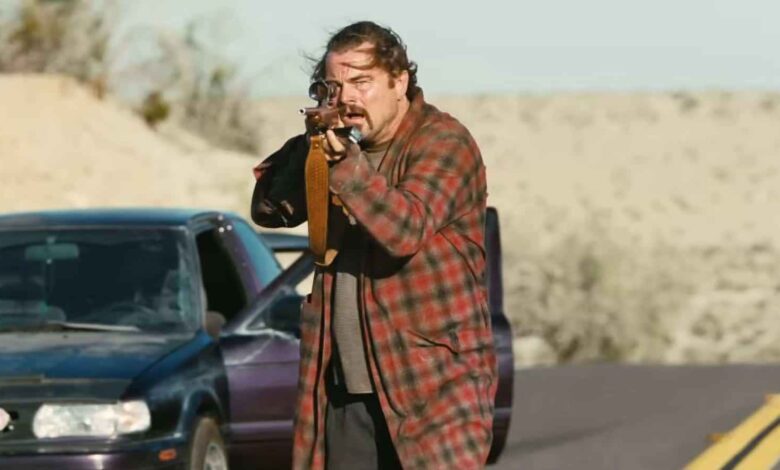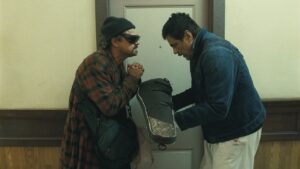One Battle After Another: Paul Thomas Anderson’s Exhilarating, Timely Masterpiece

Julie Maescher ‘27 / Emertainment Monthly Staff Writer
Light spoilers ahead.
For the last 20 years of his career, Paul Thomas Anderson has been stuck in the past. This is hardly a negative thing, of course; his illustrious body of work, ranging from novelistic treatises on 19th-century capitalistic greed (There Will Be Blood) to melancholy laments on the death of ‘60s counterculture (Inherent Vice) to ambling coming-of-age vignettes in sunny ‘70s California (Licorice Pizza), comprises arguably the most consistently rich and rewarding filmography of any living American filmmaker. As diverse and wide-ranging as each of his films are, Anderson’s recent efforts are joined together in their consistent fascination with bygone eras in our history. Anderson hasn’t made a movie set in the present day since Punch-Drunk Love in 2002, and even that film manages to feel out of time altogether in its flights of fancy and eccentric details. Anderson’s new film One Battle After Another, however, is not only set in the contemporary world, but directly confronts our intensely fraught, distressing reality with striking clarity and razor-sharp vitality.
Loosely inspired by Thomas Pynchon’s 1990 novel Vineland, Anderson transposes the skeleton of the Reagan-era novel into a distinctly modern political landscape that looks starkly similar to the current world, one characterized by persistent images of immigrant families in detention camps and militarized police violence in large cities. One Battle After Another begins with a relentlessly paced extended prologue that introduces a fictional group of militant revolutionaries called the French 75, where newcomer and demolitions expert “Ghetto Pat” Calhoun (Leonardo DiCaprio) is trying to prove his worth to free-spirited leader Perfidia Beverly Hills (Teyana Taylor) and the rest of the crew. The group is first seen in action as they liberate an immigrant detention facility on the US-Mexico border; while the rest of the team carries out their operation, Perfidia distracts and humiliates the camp’s commanding officer Col. Steven J. Lockjaw (Sean Penn). Lockjaw develops a psychosexual fixation on Perfidia, staying on the tail of the French 75 as they target banks and government buildings. All the while, Perfidia and Pat are raising a child together; Pat immediately takes to his daughter Charlene and feels ready to settle down into a more domesticated life, while Perfidia feels more torn between her duties as a parent and as a revolutionary. Eventually, Perfidia must make a tough decision whether to put herself first or not in the wake of a bank holdup gone horribly wrong, sending the French 75 into a lasting state of chaos and disarray.

Flash forward 16 years, where, as a voiceover explains, “the world has changed very little.” Pat and Charlene have now assumed the identities of Bob and Willa Ferguson, living off the grid in a woodsy and remote sanctuary city called Baktan Cross. Bob is now a perpetually stoned dad who’s aged out of his revolutionary past, spending the bulk of his days getting high and watching old movies; Willa (now played by Chase Infiniti) is a strong and self-reliant teenager who’s grown increasingly frustrated with the reality of being born into a life in hiding. She clashes with her father over his seemingly unfounded paranoia that the two of them will be caught, until Bob’s fears are suddenly validated: a series of circumstances leads Lockjaw and his military unit to descend on Baktan Cross, doggedly pursuing Bob and Willa. Bob’s old French 75 comrade Deandra (Regina Hall) returns from the shadows to extract Willa from a school dance and transport her to a secure rendezvous point, leading Bob on a hectic chase to track down his daughter before Lockjaw gets there first.
This is a lot of information to take in for roughly the first hour of a nearly three-hour odyssey, but One Battle After Another moves at a breathlessly exciting sprint from one stop of the journey to the next. The film is a nonstop rush of propulsion and forward momentum, carried out with masterful control and confidence. From moment to moment, Anderson effortlessly toggles between electrifying thrills, absurd hilarity, and grounded emotional weight without missing a beat. Anderson has never made a movie at a blockbuster scale like this, complete with thrillingly dynamic car chases and shootouts, and yet he seamlessly adapts to new territory without sacrificing any of his unique personal vision and idiosyncrasies.
This is a film that feels thoroughly alive, bursting with life and energy in every frame. One stretch in the middle of the film contains some of the most exhilarating filmmaking of Anderson’s career, as Bob enlists the help of community leader and Willa’s karate teacher Sensei Sergio St. Carlos (Benicio Del Toro), who runs a secret operation to provide evacuation and safe haven for immigrants (as he puts it, “a Latino Harriet Tubman situation”). Anderson’s camera zooms through this underground network as Sergio introduces Bob to everyone he’s giving shelter to, and even as the action remains focused on Bob and his chase, we’re given a rich sense of life and community on the surrounding margins; one instantly gets the feeling that Sergio and his modern underground railroad of sorts could easily lead a movie of their own. Anderson’s work has always been populated with vibrant details and digressions like these, and One Battle After Another is so rich in this regard that each and every viewing will inevitably highlight a new detail or sequence or supporting character to fall in love with.

Ultimately, what gives One Battle After Another so much of its power is just how earnest and surprisingly hopeful it is in reckoning with our contemporary world. Anderson doesn’t shy away from the dangers of a fascist landscape, but he meets them with a sincere belief in the value of resistance and the promise of a new generation to lead the charge. As uniquely modern as the film’s lens is, One Battle After Another feels informed by an entire history of resistance; Anderson reminds us that this fight has always existed, and it will always continue to. “We’ve been laid siege for hundreds of years,” Sergio tells Bob at one point. “Ocean waves.” Much of the film’s text concerns itself with how the French 75 ultimately failed to make lasting and meaningful change, and yet the spirit has been passed on to new movements in a new fight. Bob may not have accomplished what he wanted to, but he’s brought someone into the world who has a better chance than he did. Anderson’s sincere belief in the youth who inherited the fight to do what his generation couldn’t is deeply moving and cathartic, and he wisely chooses to end the film on a wonderfully earnest crystallization of this faith. Anderson maintains that a better world is possible, and that the kids of today’s generation will be the ones to bring us into it. At the end of the day, that’s a beautiful thing for a movie like this to leave us with.